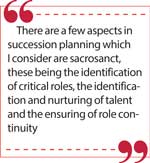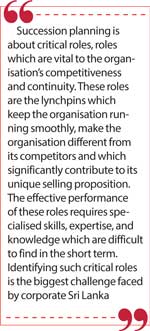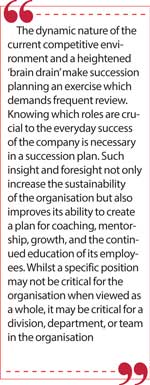Thursday Jan 15, 2026
Thursday Jan 15, 2026
Wednesday, 31 July 2024 00:20 - - {{hitsCtrl.values.hits}}

The thrust of succession planning is to ensure that the organisation has a bench of well-trained employees who can fill critical positions should a vacancy arise
 The process of ‘succession’ has been in play, and ‘succession planning’ has been in operation, in various forms, shapes and sizes since the days of yore. Commencing from the replacement of a chief of a hunter-gatherer clan of Homo Habilis about 1.5 million years ago, the process of succession, often natural and spontaneous and sometimes deliberate, has become second nature to homo sapiens.
The process of ‘succession’ has been in play, and ‘succession planning’ has been in operation, in various forms, shapes and sizes since the days of yore. Commencing from the replacement of a chief of a hunter-gatherer clan of Homo Habilis about 1.5 million years ago, the process of succession, often natural and spontaneous and sometimes deliberate, has become second nature to homo sapiens.
It has ranged from god-driven succession such as from Abraham to Isaac as described in the Bible around 1800 BC, nominated succession such as from Henry the Eighth to Edward the Sixth, Mary the First and Elizabeth the First in the House of Tudor commencing the 16th century, ‘usurped’ succession such as from Dhatusena of Anuradhapura to Kasyapa the First in Sri Lanka in 473, constitution driven succession such as from Rishi Sunak to Keith Starmer as Prime Minister of the United Kingdom in 2024, process dictated succession such as from Pope Bendict the Sixteenth to Pope Francis as the Head of the Catholic Church in 2013, planned organisational succession such as from Steven Reinemund to Indra Nooyi as Head of Pepsico in 2006, the not so well planned succession from Steve Ballmer to Satya Nadella as Head of Microsoft in 2014 and the long-planned succession from Susantha Ratnayake to Krishan Balendra as Chairman/Chief Executive Officer of John Keells Holdings PLC in 2019. While these are just a handful of examples of succession and that too at the highest levels, it must be noted that succession is applicable to all roles in society from the highest to the lowest. Succession is ubiquitous.
Unlike succession, succession planning which is deliberate and structured is sparingly deployed. Succession planning as referred to in modern corporate governance is, firstly, the identification of all roles which if unmanned or ‘unwomanned’ for too long a period pose serious risks to the operations of the organisation and consequently its level of competitiveness and, secondly, the formulation of a plan which is aimed at filling such roles with appropriately skilled persons within stipulated time frames ranging from a ‘drop dead’ situation to longer horizons.
Ensuring vacant critical positions are filled quickly
Accordingly, it is a process of identifying, selecting and developing appropriate internal talent, identifying, and maintaining, a register of external talent, including the diaspora, and recruiting them as necessary and, where relevant, infusing new competencies as per a strategic business plan. Given that persons get promoted, migrate, move to other companies and retire as a part of their employment, organisations must have a proactive approach in ensuring that vacant critical positions are filled quickly.
Succession planning is not too widely practised in Sri Lanka. Although most organisations plan for succession at the Chief Executive Officer level, there are not too many who plan succession of the many other critical roles on a proactive and coordinated basis. Even the few who do so, do not do it right. For example, about a year ago I asked the top management and the Head of Human Resources of a prominent organisation to identify its critical roles. They concluded that nearly 50% of the roles were critical. Yes, admittedly, most of the roles were important but they were not critical. It was obvious that the definition of ‘critical’ had to be sharper. Research and surveys indicate that the number of critical positions in an organisation is between eight and twelve percent of the total positions. This is a globally accepted benchmark in high-performing organisations.
Having had the good fortune of being intimately involved in establishing, fine-tuning and implementing succession planning at two ‘mega’ organisations such as Anglo-American Corporation (Central Africa) Ltd., Zambia, “Anglo” and John Keells Holdings, PLC, Sri Lanka, “JKH”, there are a few aspects in succession planning which I consider are sacrosanct, these being the identification of critical roles, the identification and nurturing of talent and the ensuring of role continuity.
 As stated earlier, succession planning is about critical roles, roles which are vital to the organisation’s competitiveness and continuity. These roles are the lynchpins which keep the organisation running smoothly, make the organisation different from its competitors and which significantly contribute to its unique selling proposition. The effective performance of these roles requires specialised skills, expertise, and knowledge which are difficult to find in the short term. Identifying such critical roles is the biggest challenge faced by corporate Sri Lanka. The determination of the critical roles presupposes a thorough understanding of the competencies and skills which are required by the organisation, today and in the future, in satisfying customer demands and remaining competitive.
As stated earlier, succession planning is about critical roles, roles which are vital to the organisation’s competitiveness and continuity. These roles are the lynchpins which keep the organisation running smoothly, make the organisation different from its competitors and which significantly contribute to its unique selling proposition. The effective performance of these roles requires specialised skills, expertise, and knowledge which are difficult to find in the short term. Identifying such critical roles is the biggest challenge faced by corporate Sri Lanka. The determination of the critical roles presupposes a thorough understanding of the competencies and skills which are required by the organisation, today and in the future, in satisfying customer demands and remaining competitive.
Questions which can be asked
The following are the questions which can be asked in such determination. * Is the subject position the sole repository of the specific knowledge and skills required to deliver the product or service, * Can the organisation operate effectively with a vacancy in that position? If so, for what maximum period? * What level of education, professional qualifications, certificates, and/or licenses are required to perform the job elements of the position? Is such education, qualifications, licenses et cetera mandatory for the subject position in terms of prevailing acts, statutes, or regulations? * What is the adequacy of the internal or external supply of the required competencies and skills in the market? How quickly can a vacancy in the subject position be filled at a market price? * Is there a high probability of the position being vacant soon?
There is a tendency for organisations to conclude that all high level managerial or leadership positions are critical. They may well be. But not necessarily because of their level in the hierarchy. Critical positions may reside at any level in the organisation. At times, it may even be a low-level position where the incumbent has acquired significant tacit knowledge which he/she has not shared nor documented for purpose of power preservation, or it may be a position where the raison d’ etre of customer allegiance is to the incumbent rather than to the organisation. These are issues that should have been identified by the organisation as a part of normal risk management. They should never have been allowed to reach a level where the positions became critical.
Initiative-taking mitigatory steps such as automated capturing of tacit knowledge, structured/indexed document management and understudy arrangements could have been used as preemptive measures. The dynamic nature of the current competitive environment and a heightened ‘brain drain’ make succession planning an exercise which demands frequent review. Knowing which roles are crucial to the everyday success of the company is necessary in a succession plan. Such insight and foresight not only increase the sustainability of the organisation but also improves its ability to create a plan for coaching, mentorship, growth, and the continued education of its employees. Whilst a specific position may not be critical for the organisation when viewed as a whole, it may be critical for a division, department, or team in the organisation. Also qualifying would be positions which management has allowed to become critical because of poor risk management. Ideally a succession plan should be created for every position. However, establishing succession plans for every individual role is unlikely to pass the cost versus benefits test, particularly in large organisations, and therefore there is the need for a selective approach based on criticality.
Succession planning and talent management
 Succession Planning and Talent Management are interdependent processes. They enjoy a symbiotic relationship. Whilst succession planning focuses on ensuring the continuity of critical positions by having the right people in the right positions at the right time, talent management aims at building a pipeline of employees who are proactively upskilled, coached, mentored, trained and developed in pursuing the organisation’s vision, mission, purpose, goals and objectives, enhancing organisational competitiveness, delivering stakeholder value and driving sustainable business growth. Talent management and talent development, collectively, constitute the strategic process of attracting, retaining, and developing high performing employees to meet current and future organisational and individual needs.
Succession Planning and Talent Management are interdependent processes. They enjoy a symbiotic relationship. Whilst succession planning focuses on ensuring the continuity of critical positions by having the right people in the right positions at the right time, talent management aims at building a pipeline of employees who are proactively upskilled, coached, mentored, trained and developed in pursuing the organisation’s vision, mission, purpose, goals and objectives, enhancing organisational competitiveness, delivering stakeholder value and driving sustainable business growth. Talent management and talent development, collectively, constitute the strategic process of attracting, retaining, and developing high performing employees to meet current and future organisational and individual needs.
Both Anglo and JKH had very robust, and well-functioning, success planning, talent management and talent development processes. Based on my experience of the same, I suggest that the following be considered when formulating a succession plan.
Opponents and proponents
 Succession planning has its opponents and proponents. I have found it to be more advantageous than disadvantageous, probably because it was practiced as it should, in the organisations I was involved. The key advantages are, * The organisation is always in a state of preparedness in dealing with the unanticipated departure of a key employee, * Identified successors are continually trained and developed to meeting pre-specified criteria, * There is an ongoing supply of well-trained and highly motivated employees, generalists, technocrats and experts, who are able to step into key positions as needed, * There are defined career paths which enable the organisation to recruit and retain competent and capable persons, * The explicit and/or implicit naming of successors minimises the probability of critical employees leaving for greener pastures, * There is a regular upgrading of knowledge capturing and retention processes, * When identifying the critical positions of the organisation there is a forced review of the current and future operating models of the organisation.
Succession planning has its opponents and proponents. I have found it to be more advantageous than disadvantageous, probably because it was practiced as it should, in the organisations I was involved. The key advantages are, * The organisation is always in a state of preparedness in dealing with the unanticipated departure of a key employee, * Identified successors are continually trained and developed to meeting pre-specified criteria, * There is an ongoing supply of well-trained and highly motivated employees, generalists, technocrats and experts, who are able to step into key positions as needed, * There are defined career paths which enable the organisation to recruit and retain competent and capable persons, * The explicit and/or implicit naming of successors minimises the probability of critical employees leaving for greener pastures, * There is a regular upgrading of knowledge capturing and retention processes, * When identifying the critical positions of the organisation there is a forced review of the current and future operating models of the organisation.
On the other hand, the key disadvantages are, *The emergence of the “crown prince syndrome”, being a syndrome which arises when top management is perceived as favouring certain individuals who directly work with them and/or are visible to them rather than giving consideration to a broader range of available employees some of whom may not be too forward in displaying their skills and abilities. Employees who have worked on high-profile projects, have influential mentors, or have strong networks of organisational leaders fall into this category, * Selecting someone too prematurely. A better candidate may appear later, * A successor may rest on his laurels and adopt an attitude of complacency on the grounds that he/she is the chosen heir. This can be mitigated by frequently reviewing the named successors and determining whether they should continue to remain in the talent pool or succession bench.
The thrust of succession planning is to ensure that the organisation has a bench of well-trained employees who can fill critical positions should a vacancy arise. Failure to do so will leave the organisation very vulnerable to its competitors. Mmanti Umoh, the award-winning Management Consultant and Education Psychologist states it aptly; “Without the right succession planning put to play in human resources, we build for the future without a future”. Succession planning should not be relegated to the status of a neglected tool.
(The writer is currently a Leadership Coach, Mentor and Consultant, and boasts over 50+ years of experience in very senior positions in the corporate world – local and overseas. www.ronniepeiris.com.)